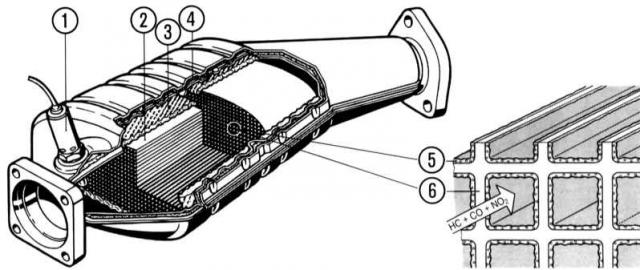Duratec-HR example: two lambda sensors in carbureted engines
 |
|
1 - Pre-activated lambda sensor,
|
3 - Catalyst,
|
Chemically renders up to 90% of the constituents of the exhaust gas harmless: three-way catalyst
1 out of 2 CO O2 becomes CO2; from 2 C2 N6 7 O2 became 4 CO2 6 N2O; 2 NO 2 CO yields N2 CO2.
 |
|
1 - Lambda sensor,
|
4 - Heat-containing double bowls,
|
Most fuel consists of components such as carbon and hydrogen. When burned in an engine, carbon combines with oxygen from the air to form carbon dioxide (CO2), and hydrogen (H) with the same oxygen (About2) creates water (N2 O). Approximately 0.9 liters of water are produced from one liter of fuel. It is removed as «invisible» water vapor from the exhaust system. However, during cold starts in winter, white exhaust clouds can often be observed - an indirect sign of condensed water.
Mondeo with regulating catalytic converter - diesel with oxidation catalyst - all Mondeo with EGR
All Mondeos with gasoline engines today run with a single regulating catalyst, including an exhaust gas recirculation system. In contrast, diesel variants have a single oxidation catalyst and an exhaust gas recirculation system on board. The control catalyst reduces carbon monoxide by about 85%, hydrocarbons by 80% and nitrogen oxides by almost 70%. Oxidation Catalyst Leaves Nitrogen Oxides Alone (the recirculation system thinks about it). Designation «adjustable» indicates that the exhaust gas emissions, unlike with the oxidation catalytic converter, are actively measured during operation and corrected in the range of the minimum prescribed by the standards. As the distance traveled grows (mileage) each catalyst, however, loses its «influence».
Measures the oxygen content in the exhaust gas - lambda sensor
To shorten the reaction time «poisonous lard», in the Mondeo, an oxygen sensor is integrated directly into the exhaust manifold and behind the catalytic converter. It continuously analyzes the residual oxygen content in the exhaust gas. Their «intelligence» it sends to the electronic control unit: depending on the current measurements, the on-board computer sets the composition of the air-fuel combustible mixture (poor, rich). This is done in a rapidly changing sequence. Excess air for hydrocarbon combustion, lack of air to reduce nitrogen oxides. «Adjustable» the exhaust gases pass through a catalyst, which - as mentioned above - converts them into carbon dioxide, water vapor and nitrogen.
Catalyst Operating Temperatures
In order for the catalyst and lambda sensor to function, it is necessary to reach their operating temperatures (catalyst: about 300°C). This work is performed by hot exhaust gas for 25–80 seconds. However, these two elements react very sensitively to too much heat. For example, when unburned residues of the combustible mixture ignite in a hot catalyst (interruptions in ignition), temperatures inside can rise to dangerous levels. Temperature constancy in the region of 1200°C can prematurely age the catalyst, at temperatures above 1400°C the ceramic body melts and the lambda sensor heats up too much. The melted catalyst can «expose» by using «good ears» by hissing exhaust noises - this is due to increased back pressure of the exhaust gas - and sharp power losses. Immediately start finding out the reasons, otherwise the new catalyst under your Mondeo will have a short life, and the exhaust valves in the cylinder head will burn out in a very short time.
Pay attention to misfiring: especially when shifting from high gears or driving down mountain roads in forced idle mode - if sounds are heard from the exhaust system, thoroughly get to the bottom of the cause of this phenomenon.
| PRACTICAL ADVICE | |
|
Visitor comments